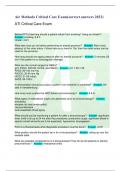Air Methods Critical Care Exam(correct answers 2023)
ATI Critical Care Exam
Before PFT's how long should a patient refrain from smoking? Using an inhaler? -
Answer- smoking: 6-8 h
inhaler: 4-6 h
What test must you do before performing an arterial puncture? - Answer- Allen's test;
patency of the ulnar artery- if blood returns to hand in 15s, then the radial artery can be
used for the puncture
How long should one apply pressure after an arterial puncture? - Answer- 5 minutes (20
min if the patient is on anticoagulant therapy)
What are the normal ranges for ABG's?
(pH, PAO2, PACO2, HCO3, and SAO2) - Answer- pH: 7.35-7.45
PAO2: 80-100 mm Hg
PACO2: 35-45 mm Hg
HCO3: 21-28 mEq/L
SAO2: 95-100%
In what position should you place a patient if air embolism is expected? - Answer- left
side in trendelenburg
How long must a patient be NPO before a bronchoscopy? - Answer- 4-8 hr
What types of medications might one administer prior to a bronchoscopy? - Answer-
anxiolytics
atropine (to treat bradycardia)
viscous lidocaine
local anesthetic throat spray
What should you be monitoring a patient for after a bronchoscopy? - Answer- significant
fever (mild is ok up to 24 hrs after the procedure), productive cough, significant blood in
sputum (small amounts are to be expected), hypoxemia, laryngspasm
Prior to a thoracentesis what diagnostic procedure must be done? - Answer- CXR
What position should the patient be in for a thoracentesis? - Answer- sitting up over the
bedside table
What are possible complications of a thoracentesis? How do we tell patients to identify
pneumothorax? - Answer- mediastinal shifts
,pneumothorax (deviated trachea, pain at the end of inhalation or exhalation, affected
side not moving with breath, increased HR, shallow respirations, nagging cough, air
hunger)
In what chest tube chamber (ONLY) should you see bubbling? - Answer- suction
What is excessive drainage from a chest tube? - Answer- more than 70 ml/hr
How should the nurse document for care following a chest tube? How often? - Answer-
color and amount of drainage qh for 24h after insertion, then q8h
mark date, hour, and drainage level on the container at the end of each shift
What supplies should be kept at the side of a bed for a patient with a chest tube? -
Answer- 2 enclosed hemostats, sterile water, occlusive dressing
What should the nurse instruct the patient to do during chest tube removal? - Answer-
valsalva maneuver
What should the nurse do in the case that a chest tube is disconnected? - Answer- 1.
have the client exhale as much as they can to remove air from the pleural space
2. immerse the end of the chest tube in sterile water to restore the water seal
3. apply dry sterile gauze
What is the FiO2 and the flow rate for a nasal cannula? at what rate do we need to
administer humidification? - Answer- 24-44%
1-6 L/min
humidification at 4 L/min
What is the FiO2 and the flow rate for a simple face mask? - Answer- 40-60%
5-8 L/min (less than this causes the patient to rebreathe CO2)
What is the FiO2 and the flow rate for a partial rebreather mask? - Answer- 40-75%
6-11 L/min
What is the FiO2 and the flow rate for a non-rebreather? - Answer- 80-95%
10-15 L/min
What is the FiO2 and the flow rate for a venturi mask? - Answer- 24-50%
4-10 L/min
What is the FiO2 and the flow rate for a aerosol face mask, face tent, t-piece, and trach
collar? - Answer- 24-100%
10 L/min at least
*** Humidification requires frequent monitoring
What does hypercarbia look like? - Answer- restlessness, hypertension, HA
, What does oxygen toxicity look like? - Answer- non-productive cough, substernal pain,
nasal stuffiness, n/v, fatigue, HA, sore throat, hypoventillation
How does assist control (AC) work related to respiratory support? - Answer- overtakes
breathing for an intubated client
How does synchronized intermittent mandatory ventilation (SIMV) work related to
respiratory support? - Answer- used in weaning; increases the work of breathing
ventilator and patient work together
How does assist inverse ratio ventillation (IVR) work related to respiratory support? -
Answer- prolongs the inspiration phase to maximize oxygenation
HIGH RISK FOR VOLUTRAUMA
How does airway pressure release ventilation (APRV) work related to respiratory
support? - Answer- patient and ventilator work together
breath expelled by the lung's own natural recoil
How does independent lung ventilation work related to respiratory support? - Answer-
lungs are ventilated separately
need: 2 ventilators, sedation, neuromuscular blocking agents
How does PEEP work related to respiratory support? - Answer- preset pressure on
expiration
added to treat persistent hypoxemia
How does pressure support ventilation (PSV) work r/t respiratory support? - Answer-
greater oxygenation, makes the work of breathing easier, prevents alveolar collapse
How do you document the placement of a tube for mechanical ventilation? - Answer- in
cm at the client's teeth or lips
What do the three ventilator alarms indicate? (volume, pressure, and apnea alarms) -
Answer- volume (low pressure): low exhaled volume due to a disconnection, cuff leak,
or tube displacement
pressure (high pressure): excess secretions, client biting the tube, kinks in the tubing,
coughing, pulmonary edema, bronchospasm, and pneumothorax
apnea: ventilator does not detect spontaneous respiration in a set time period
For an ET tube what should the cuff be set at? how often should you adjust the cuff
pressure? - Answer- 20 mm Hg
q8h
How long should you recommend that clients take decongestants? - Answer- no longer
than 3-4d (rebound decongestion)




